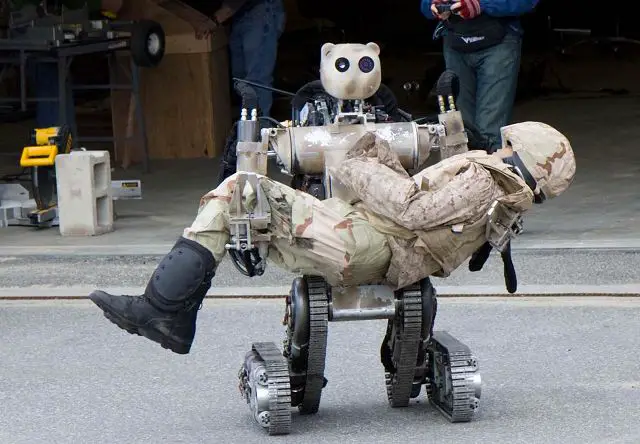In the future U.S. Army could use unmanned aerial or ground vehicles to recover injured soldiers 12509153
|
|
|||
|
Military Defense Industry Technology - US Army Medical robot
|
|||
|
|
|||
| In the future U.S. Army could use unmanned aerial or ground vehicles to recover injured soldiers. | |||
|
In the near future, U.S. army could use Army-operated unmanned aerial or ground vehicle as medical unit to save live on the battlefield and to recover injured soldiers. In the near future, however, it may no longer be another Soldier, who comes running to his side. Instead, it might be an Army-operated unmanned aerial or ground vehicle, said Maj. Gen. Steve Jones, commander of the Army Medical Department Center and School and chief of the Medical Corps.
|
|||
|
|
|||
 One day, unmanned vehicles, similar to but larger than this small unmanned ground vehicle, may roll onto battlefields to rescue downed Soldiers, said the commander of the Army Medical Department Center and School. One day, unmanned vehicles, similar to but larger than this small unmanned ground vehicle, may roll onto battlefields to rescue downed Soldiers, said the commander of the Army Medical Department Center and School. |
|||
|
|
|||
|
"We have lost medics throughout the years because they have the courage to go forward and rescue their comrades under fire," Jones said. "With the newer technology, with the robotic vehicles we are using even today to examine and to detonate IEDs [improvised explosive devices], those same vehicles can go forward and retrieve casualties." Jones spoke at an Association of the U.S. Army-sponsored medical conference near the Pentagon, Sept. 22. "We already use robots on the battlefield today to examine IEDs, to detonate them," he said. "With some minor adaptation, we could take that same technology and use it to extract casualties that are under fire. How many medics have we lost, or other Soldiers, because they have gone in under fire to retrieve a casualty? We can use a robotics device for that." Jones said unmanned vehicles used to recover injured Soldiers could be armored to protect those Soldiers on their way home. But the vehicles could do more than just recover Soldiers, he said. With units operating forward, sometimes behind enemy lines, the medical community could use unmanned aerial vehicle systems, or UAVs, to provide support to them. "What happens when a member of the team comes down with cellulitis or pneumonia? We have got to use telemedicine to tele-mentor them on the diagnosis and treatment," he said, adding that UAVs could be used for delivering antibiotics or blood to those units to keep them in the fight. "So you don't have to evacuate the casualties, so the team can continue its mission."
|
|||
|
|
|||
 Battlefield Extraction-Assist Robot is an all-terrain, search-and-rescue humanoid robot that can lift and carry up to 500 pounds, yet can grasp fragile objects without damaging them. Battlefield Extraction-Assist Robot is an all-terrain, search-and-rescue humanoid robot that can lift and carry up to 500 pounds, yet can grasp fragile objects without damaging them. |
|||
|
|
|||
|
Other technology that Jones said already exists, sensors that could monitor a Soldier's vital signs, for instance, might also one day make their way to the battlefield, being worn by Soldiers full time.
"Army Medical Research and Materiel Command is actually developing physiological sensors that Soldiers can wear," Jones said. "And in a few years, they will be able to field this. They can be wearing the sensors and we can just monitor them. And we can do that remotely." The general likened the sensors to something like a "Fit Bit," which Soldiers might wear now to monitor their heart rate and steps taken. "This is just a step forward that will monitor other physiological parameters," he said. "Do they need to push more water? How many calories have they consumed? There is a lot of information we can provide commanders that they can use to manage their Soldiers." The same sensors could be used to triage casualties automatically, so that those injured Soldiers whose vital signs are the worst are the ones who get rescued first. "If you see a casualty whose heart rate is way up, whose respiratory rate is way up, that may be an indication they lost a lot of blood, and need treatment now, as opposed to a casualty whose vital signs are stable and you wouldn't have to treat as quickly," he said. The same sensors can also be installed on unmanned aerial vehicles that might one day rescue Soldiers when they go down. Jones also discussed the use of "GoPro" cameras on Soldiers to document wounds and treatment that is administered. Such video, he said, can be transmitted real-time to follow-on treatment facilities where it can be used by physicians there to better understand exactly what treatment a Soldier has already received. Additionally, such footage could be used to provide feedback to the medics who performed the initial care to help them improve their skills. The Army is doing something similar now, he said, through the use of medical simulators. "[We] train combat medics in simulators and record treatment they provide and play it back for them," he said. "We show them how they entered the scene, how they surveyed their casualties, how they decided which casualty to treat or not treat. And then we talk to them about the treatment they actually provided."
|
|||


























